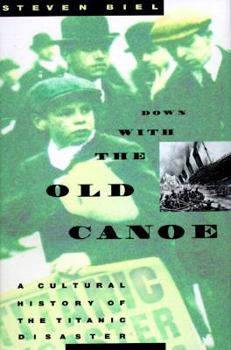Down with the Old Canoe: A Cultural History of the Titanic Disaster
Select Format
Select Condition 
Book Overview
An exploration of the Titanic as a cultural icon, this book recalls the moment, in April 1912, when the Titanic struck an iceberg and sank. The disaster was the signal for many people, such as reformers, radicals and extremists of all kinds, to exploit it: suffragettes and their opponents, radicals, reformers and capitalists, critics of technology and modern life; racists and xenophobes, and champions of racial and ethnic equality; editorial writers and folk singers, preachers and poets. Even today, the Titanic echoes in the headlines and in everyday speech. This text analyzes how and why the disaster happened, and why it took shape as one of the great mythic events of the 20th century.
Format:Hardcover
Language:English
ISBN:039303965X
ISBN13:9780393039658
Release Date:September 1996
Publisher:W. W. Norton & Company
Length:300 Pages
Weight:1.30 lbs.
Dimensions:1.2" x 5.8" x 8.5"
Customer Reviews
4 ratings
An original approach to a classic subject
Published by Thriftbooks.com User , 20 years ago
Plenty of books recount what happened the night the Titanic sank, but this one does something different. It traces how people have understood that night, mostly in the United States, in the decades since. For example, the Titanic figured into the arguments of both opponents and supporters of women's suffrage in 1912. It entered into African American culture in the form of folk songs and spoken-word poetry (the precursor to rap). It's been the subject of poems, novels, songs, musicals, and (of course) movies. James Cameron's 1997 film--the highest grossing movie of all time--is just one attempt to make the disaster speak to contemporary concerns. With intelligence and wit, Biel shows that many meanings can come from an event. If you want to read a narrative account of the Titanic disaster, try "A Night To Remember." But for the hows and whys of remembrance, read this wonderfully researched book, which is gracefully written and often funny.
Historical context (and then some) for the "Old Canoe"
Published by Thriftbooks.com User , 26 years ago
Steven Biel writes with a detail and depth of knowledge of his subject. The disaster becomes a touchstone for aspects of popular American culture, a prism through which various 20th century concerns are seen, even as Titanic-as-metaphor becomes increasingly mythic and removed from the actual event.
A clever look at society's reaction to Titanic's sinking
Published by Thriftbooks.com User , 26 years ago
This is one of the few Titanic books currently in print which does more than rehash the same old sinking story. Instead, it looks at the reaction of society to the greatest marine tragedy of all time.The success of Biel's book hinges on his meticulous research and thorough reporting of his findings. One chapter examines how the New York press reported the tragedy in the days following the sinking. Many authors are content to re-state what the New York Times said (accurately reporting that the ship had sunk), and what the New York Sun said (inaccurately reporting "All Saved From Titanic After Collision"). Biel digs deeper, and presents a range of reactions that vary from honest, dedicated journalism to wild speculation. Biel's also examines how the Titanic affects us to this day. His analysis of Titanic movies such as "A Night to Remember", "Titanic" (1953), and "Raise the Titanic" give the reader a new perspective on these often-overlooked films. More than cinematic re-tellings of the sinking, they reveal the feelings and values of the people who made them.Although it is not the most exciting of novels, it is a brave work that, like prospectors looking for gold, successfully finds new material in a world of tired, re-hashed, and looked-over facts.
Great Titanic Book!
Published by Thriftbooks.com User , 27 years ago
This was a very good book, although it fails achieve a high score. The text was fairly interesting and the pictures hardly held my interest. Had a few very interesting facts, though.






